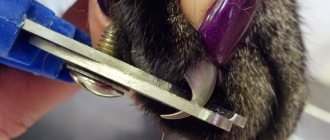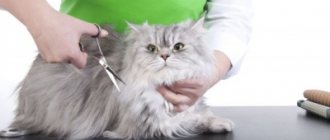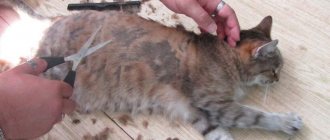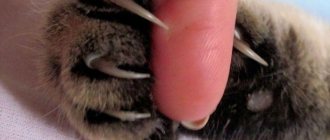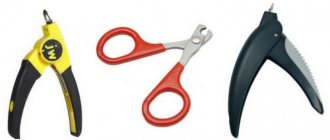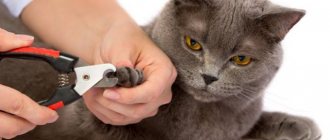What's special about a cat's claws?
The cat's claws are interesting because they are retractable. Thanks to the unique structure of tendons and ligaments, nails can:
- hide when running or sneaking up on game;
- pull when jumping on prey, climbing, defending itself.
Cats mark trees with their claws to mark their territory. At the same time, they release pheromones that signal their presence to other cats. This way, when the cat is at rest, the claws do not touch the ground and wear down naturally, as in dogs.
Both wild and domestic cats need claws to walk properly. Unlike other animals, when walking they do not rely on their feet, but only on their toes. The heel does not touch the ground.
Do I need to trim my cat's claws?
Whether cats can have their claws trimmed depends on the pet’s lifestyle – whether she walks outside or just sits at home. In the first case, nails are needed for protection, hunting, and climbing. She won't survive in the yard without them.
When you have an indoor cat, claws grow quickly and there are no natural mechanisms to wear them down. The animal is forced to grind them off - on furniture, walls, and other objects. There is no point in punishing a cat for this - it is a reflex that cannot be eliminated. To direct your instinct in the right direction, you definitely need to buy a scratching post and don’t forget about cutting the plates.
Why trim cats' claws? As pets age, they lose activity, stop using scratching posts, and damage furniture. The plates still need to be cut off, since they will grow back, bend, and can penetrate into the pad and cause inflammation. Especially often the problem occurs with the fifth, most inconspicuous nail. The only way out in this case is surgical intervention.
Another reason why veterinarians answer yes to the question of whether cats need to have their nails trimmed. This is delamination of the plate, which leads to its breakage. Sometimes the claw can break down to the meat. In this case, the cat will be in great pain and will begin to limp.
Which animals are not recommended for the procedure?
There is no need to trim the claws of a cat that roams freely outside. She needs her nails to climb trees, hunt and defend herself from other four-legged animals.
Also, the procedure is not performed on kittens under 1 month of age. Their claws are not yet formed. Early cutting negatively affects the structure of the nail plate and leads to delamination.
But already at 2 months the claws are strongly extended, and the kitten begins to scratch. At this time they can already be cut.
How can you trim a cat's claws?
Can a cat's nails be trimmed with scissors? To tidy up your paws, buy tools designed not for people, but for cats. They are more convenient to work with and the risk of injury is minimal. In addition, even the sharpest nail scissors are not suitable for cutting animal plates.
To trim a cat's claws at home, you will need:
- Plate shears or sickle or guillotine type nail clippers. Ideally, it should be a tool with stainless steel knives and handle pads that will not allow your hand to slip.
- Cotton wool or gauze in case of bleeding.
- Disinfectant (eg hydrogen peroxide).
- Gloves made of leather or thick fabric that will save your hands from scratches.
- Manicure file.
Nail trimming tools must be sharp. Before the procedure, wipe the knives with a disinfectant to avoid infection if an accidental cut occurs.
Claw clippers
When considering whether to trim your cat's nails, consider nail clippers. Give preference to the guillotine type. It is more convenient to use and cuts plates better. The sickle-shaped tool is intended for animals whose claws are stronger than those of a cat.
Possible complications after cutting nails
In addition to cutting tools, it is advisable to have some medications with you: hydrogen peroxide, iodine and baby powder.
An inexperienced owner can injure his paw, this is unpleasant, but there is no need to panic. If blood bleeds while grooming a cat, you should fill the wound with peroxide and calm the patient down. The bleeding stops in a short time.
After this, you can sprinkle the damaged area with talc or zinc oxide powder.
Before each use, treat scissors and nippers with an antiseptic solution.
At what age should a kitten's nails be trimmed?
Is it possible to trim kittens' nails? Yes, but not for newborns. Small cats do not know how to remove their claws. They are constantly released and spread out. They use marigolds from the first days of life, massaging their mother's nipple with their paws to stimulate milk synthesis. At first the claws are soft and short, then they begin to harden and by 6-8 weeks they leave the first scratches.
When can you trim a kitten's nails? Not earlier than 3 months. The plates harden completely by 6 months. By this time, the kitten can already be accustomed to the procedure.
How to trim a kitten's claws correctly
The sooner you start accustoming your cat to trimming its claws, the fewer problems will arise during the procedure. It is important that the first manipulation goes smoothly, without pain or discomfort, otherwise the cat will resist in the future.
How to trim a kitten's claws at home: precautions
Before you start cutting the plates, you need to find out how a kitten’s nail works. It consists of 2 parts - keratinized and living (pulp), where nerves and blood vessels are located. The pulp looks like a dark or pink formation. If you touch it while cutting the plates, the cat will be in pain, will bleed, and will not voluntarily agree to a repeat procedure. Therefore, cutting nails must be approached carefully and carefully.
Step 1. Prepare the kitten mentally
Claw trimming needs to be taught carefully. Both you and the kitten should be calm during the procedure. It is advisable for the pet to be relaxed and even sleepy (for example, after eating). Take other animals from the room - cats, dogs, birds. To prevent your cat from reacting to pigeons, close the curtain.
Step 2. How to trim a cat's claws: train the paw to be petted
Sit on a chair in a quiet, quiet room with the kitten on your lap. Start stroking him, paying attention to his paws. Gently touch each pad. Do not squeeze or pinch the paw. The pet should get used to the fact that you often caress its legs. You can also stroke it behind the ears and in other places where the cat likes it.
Apply gentle pressure to the pad so that the nail comes out. Then lower your paw and give your baby a treat. After some time (preferably the next day), repeat this with the other finger. Do this until you have worked on all the claws.
Step 3. Trimming claws: introduce your pet to the tool
The cat should respond calmly to the clicking sounds of the scissors. Periodically hold the tool in your hand and click close to it. Do this until the cat stops reacting to it.
Step 4. How to trim a cat’s claws yourself: step-by-step instructions
- Place your pet on your lap. Take the paw with one hand and the nail clipper with the other.
- Start massaging the paws, pressing on the pad to stretch the claws.
- Select one finger and carefully examine it to determine where the pulp ends.
- Where to trim cats claws? You only need to cut off the white part of the plate, no less than 2 mm from the pulp. If you are cutting for the first time, you can increase the distance even more and cut it off a little.
- How to trim a cat's claws with a nail clipper? Hold the pliers perpendicular to the plate. If they are placed parallel, the nail may separate.
- To smooth the tip, you can use a nail file.
- As soon as you trim 1 claw, reward your cat with a treat.
- Never cut more than 2 plates at one time - it will be uncomfortable for the cat.
- At first, treat not two, but 1 paw.
- If you accidentally injure your pet, use a cotton swab to stop the bleeding.
Types of devices
There are variations of nail clippers of different types, models, shapes and designs. There are some that are very easy to use - they are suitable for novice cat owners, and there are special ones designed for professional breeders and groomers.
Before going to the store, it is better to find out what the differences are between the main types of nail clippers, as well as their advantages and disadvantages.
Guillotine
This type of tool consists of two working parts: movable and fixed. Trimming is performed by a moving part, which is installed perpendicular to the claw placed in a special hole. The use of guillotine claw clippers requires certain skills, since when fixing the nail plate it is not visible. However, despite this disadvantage, guillotine-type tools are very popular - especially among owners of large cats with hard claws.
Scissor nail clipper
Scissors are the simplest solution. Outwardly, they resemble human manicures, only with rounded blades and a hole in the middle. It is intended for laying the claw and fixing it during the procedure.
The tool is very easy to use: you place a cat's claw in the notch, the handles close together, and the result is a neat, smooth cut. Suitable for small cats and kittens.
Nail clipper-secateurs
Resembles regular wire cutters or needle nose pliers. The handles have rubber linings, fit comfortably in the hand and do not slip. The spring included in the mechanism also makes working with the accessory easier. The cut is better than that of scissors.
Most models are equipped with a special limiter that sets a certain length and protects against cutting off excess. A special safety lock blocks the cutting surfaces when the pliers are not in use. There are straight and curved models on the pet products market.
Electric nail clipper or grinder
This is a power tool, so it is the most functional and expensive. During operation, the grinder head with an abrasive coating rotates and grinds down the claw plate like a nail file. The device comes with various attachments and limiters.
A beginner without the skill of working with an electric grinder can easily injure a pet by affecting the living part of the claw. Such devices are more often used in professional grooming salons. In stores you can find models that operate on mains power, batteries, and rechargeable batteries.
How to trim a cat's claws if she's struggling
Do cats need to have their nails trimmed if they don't like the procedure? Before trimming an aggressive cat's nails, swaddle her in a towel. And only then treat your nails. This will protect both you and the animal from injury. Do not shout or punish your pet - this will make the situation worse. Speak in a soothing, gentle voice.
You can also contact a specialist, but keep in mind that with him she will resist more. There is a high probability that he will not be able to calm your pet and trim the plates efficiently.
Where is the best place to trim a cat's claws?
If you are afraid of injuring the kitten, cutting off the plate incorrectly, you can trim the cat’s claws at a veterinary clinic or at a groomer. It is better for a specialist to come to your home, especially if you do not have vaccinations. In a familiar environment, the animal will feel calmer and less distracted.
If the specialist only works in the clinic, buy a carrier to take the cat there. Otherwise, the animal may escape along the way.
In order not to constantly call a specialist, ask him to show you how to properly cut the plates. The first few times, do the procedure under his supervision. Then handle it yourself.
Alternative Methods
If your cat categorically refuses to get a pedicure and it is inconvenient to take him to the veterinary clinic every month, you can consider alternative methods:
- Anti-scratch. Special overlays (caps) prevent damage to the furniture, but it is uncomfortable for the animal to walk, and the horny plates still grow and need to be cut off.
- Onychectomy or soft paw surgery. A difficult procedure for the animal, during which part of the cat’s fingers is taken away. Animals' paws become deformed, they lose coordination, and suffer from pain. Condemned by many veterinarians and breeders. In a number of countries the operation is prohibited.
Useful tips
- Never trim the plates if the cat is agitated or upset.
- Take your time during the procedure. One awkward movement can lead to injury, injury, or frighten the animal.
- Do not try to treat 2 paws at once, especially when you are just accustoming your pet to the procedure.
- Don't forget about the claw on the 5th finger. If it grows into the skin, it will be very painful for your pet.
- Don’t forget to praise the cat after trimming each claw and give a treat at the end of the procedure.
- Should a cat's back claws be trimmed? Yes, but not as often as the front ones. The back plates grow more slowly.
Is it necessary to remove claws?
Don't remove the claws! During onychectomy, not only the plate is removed, but also the phalanx of the finger from which it grows. Only a very young cat can survive surgery without consequences, and the procedure itself carries many risks.
Among them:
- blood loss;
- infection;
- nerve deformation;
- disturbance of gait, balance, coordination due to the fact that the pet will be forced to step on the pad and not the fingers;
- deterioration of character due to the fact that the cat feels vulnerable and unable to defend itself.
Instead of removing the plate, trim it regularly, use a scratching post. If you don't have time to trim, buy soft silicone covers for cat nails. As the plates grow, they come off (after 2-4 weeks), and the procedure must be repeated. During this time, the claws become soft and dull, and therefore the cat will not be able to damage the furniture with them.
Other solutions
Cats have a natural instinct - they take care of their claws themselves. Starting from the age of one month, kittens sharpen them with their teeth, scratch the bedding, use a scratching post or other objects, removing the dead outer shell of the claw.
To preserve furniture and other interior items from damage, owners are looking for various options. A good method of training and protecting furniture is a scratching post. You can buy it at a pet store or make it yourself. A board or post with a rough hard covering is installed in a place accessible to the pet. If you teach your kitten to use the device from childhood, you can keep the sofa and wallpaper in the room.
Pet stores sell special silicone claw covers. Their advantage is that the cat can calmly play with small children and sharpen its claws on any surface without fear of leaving damage. However, it is not recommended to use them for a long time, and even more so, you should not put the pads on animals that are walking on their own: in case of danger, the cat will not be able to climb a tree or rise to a different height.
The most cruel decision of the owners is to remove the claws. In most countries of the world, this manipulation is strictly prohibited and is punished as cruelty to animals. During the operation, not just a claw is removed, but part of the phalanx - almost the same as cutting off a person’s fingers. This cripples the animal and makes it disabled.
After onychectomy, performed under anesthesia, which in itself is dangerous for the cat, the structure of the skeleton is disrupted, and this negatively affects the functioning of all body systems. The cat is not only exposed to stress and danger - its coordination and sense of balance are impaired, it can fall even from a small height and be seriously injured.
Animals' character changes, they become irritable and even aggressive. Therefore, it is much easier to teach a kitten to use a scratching post from an early age and regularly trim its sharp claws.
